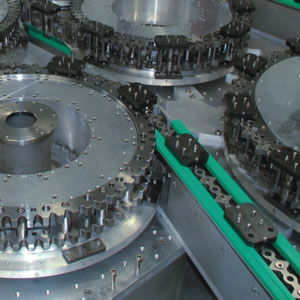Technology
Inverted tooth conveyor chains and chain drives offer a multitude of strengths by design. Depending on the required length and width, the inverted tooth chain can be individually constructed using a variety of link plates and profile pins. The result is a powerful and flexible chain drive that makes other drive and transport solutions pale in comparison.
In conjunction with the low impact typical for tooth chains, this drive solution is distinguished by extremely smooth, even running, combined with ultimate precision. Inverted tooth chains can also be used in harsh ambient conditions, at high temperatures, or with aggressive chemicals.
Inverted tooth chain structure
The construction and design of an HPC inverted tooth chain are described below as an example of tooth chains with a 2-part rolling pivot
The individual inverted tooth chain elements:
- Toothed plates
- Guide plates
- Rolling pivot joint – consisting of 2 profile pins
- Rivet washers
Chain links
Each link (aka “pitch”) will have a certain number of link plates arranged in a staggered configuration from link to link. These links are connected to one another by the rolling pivot joint. Each link plate is provided with two joint bores to accommodate the rolling pivot joint.
Variable sizes
The individual tooth chain length and width are determined by the number and properties of the plates and profile pins. This permits tooth chains with varying configurations that fulfill a wide range of requirements and can be used in numerous applications.
Riveted or laser-welded
The longer profile pin (axle pivot) is riveted either to the rivet washer or directly into the outer plate and thus secures the plates together at the sides.
In addition to these connection types, the axle pivot is usually laser-welded to the outer plate, especially on inverted tooth conveyor chains.
Centre guides and side guides
The top image in the start display shows an HPC inverted tooth chain with a centre guide. On a centre guide, the guide plates are centrally arranged in order to centre the inverted tooth chain on the sprocket toothing. Tooth chains with side guides contain guide plates on the outer sides of the chain.
Force and motion
The transmission of force and motion occurs through contact between the outer toothed plate flanks and the sprocket toothing (involute toothing). The outer toothed plate flanks usually form a 60° angle.
Precision
Precise and durable – Renold inverted tooth chains
With chain drives, the toothing and meshing conditions are similar to those of gear drives. When in new condition, the chain links enmesh with the tooth flanks until both surfaces make full contact. An increase in length results in a larger chain pitch and pitch circle diameter. In the sprocket, the chain ascends a larger diameter, corresponding with the extended chain pitch see figure at right. The two-part rolling pivot joint allows all chain links (joint centers) to occupy a common working circle.
The figure on the left shows a roller chain that consists of outer and inner links. There is wear on the outer link bolts and the inner link bushings. The roller centers maintain their position on the bushings, i.e. only the pitch of the outer link is subject to twice the rate of wear.
The outer links take up a higher pitch circle compared to the inner links. This causes uneven running of the chain, as well as noise, vibrations, and uneven strain on the sprocket toothing.
With a perfect match of chain and sprocket, Renold inverted tooth chains minimize the chain link impact intensity, thus enabling extremely quiet operation.
This is particularly advantageous for applications with speeds up to 50 m/s, which can be achieved thanks to the two-part rolling pivot joint and special link plate forms characteristic of Renold inverted tooth chains.
During joint movement, both profile pins in the rolling pivot joint roll off each other, without any sliding friction. This guarantees minimum wear and a long service life.
Assembly and lubrication
A well-lubricated inverted tooth chain is strongly recommended. Depending on ambient conditions, a dry-running chain can experience a much shorter service life. The oil film placed on the chain is for corrosion protection only and does not act as a lubricant.
An overview of the different procedures:
- Grease, drip, and spray lubrication
- Bath lubrication
- Automatic lubrication devices
- Forced feed lubrication
Please use the correct lubrication.
Sprockets
Inverted tooth chains and sprockets in perfect harmony
Correct toothing corresponding to the inverted tooth chain type is a must for the reliable function and a long service life of inverted tooth chains.
The tip diameters specified in the product overviews only apply to wrap drives. Sprockets with special toothing are required for use without a wrap (tangential meshing).
Please note this application requirement in your request.
We deliver ready-to-install sprockets according to your specifications. If quiet running is a priority, wheels with higher numbers of teeth are preferred for higher speeds.
When determining the number of teeth, the outside space required – including the applied chain – and the permissible sprocket bore needs to be taken into account in addition to the minimum number of teeth for the respective type.
Properly machined sprockets are essential to the inverted tooth chains safe operation and long service life. Using sprockets from other manufactures invalidates the tooth chain warranty.
